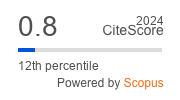Cellular Automation Model of Phase Separation during Annealing of Non–Soichiometric Silicon Oxide Layers
https://doi.org/10.17073/1609-3577-2014-2-109-115
Abstract
The suggested model simulates the structural evolution of the SiOm (m < 2 ) layer with a thickness of the order of 3—30 nm and the formation of Si nanoclusters in that layer during thermal annealing at temperatures of 900—1200 °C. The model does not take into account the crystallinity or amorphous structure of the nanocluster. The 3D cellular automaton model implemented by means of SoftCAM software (CA) on 3D cubic grid with a cell scale of 0.54 nm is synchronous, does not use Margolus’s block neighborhood and is open to the incorporation of ab initio calculations for SixOy clusters. The state of the CA cell is determined by three variables (x, y, z), taking on 0,1,2 , ..., 255 and corresponding to the number of atoms of silicon and oxygen and the arbitrary “free volume” in a cell and the fourth variable δ, taking on 0, 1, 2 and corresponding to cells belonging to nanoclusters, SiOx matrix or the interface between them. The local transition rules are determined from the following considerations: 1) for each cell, the scalar “free energy” is calculated similar to the thermodynamic potentials, as it depends only on the state of the cell; 2) the “free energy” consists of three parts: the internal U(x, y), the elastic G(z) and the surface E(δ); 3) the matter exchange between cells is determined by probabilities depending on the difference between the “free energy” by the Fermi— Dirac relation. The model traces the total number of nanoclusters, their average size and the average distance between them. The simulation results are consistent with published experimental data.
About the Authors
G. Y. KrasnikovRussian Federation
General Manager, Academician of Russian Academy of Sciences
N. A. Zaitsev
Russian Federation
Head of Department, Dr. Sci. (Eng.);
I. V. Matyushkin
Russian Federation
Head of Laboratory, Cand. Sci. (Phys.–Math.)
S. V. Korobov
Russian Federation
Software Engineer.
References
1. Cooks, M. Flash fast forward to quantum dot memory / M. Cooks // Semiconductor Today. Compounds and Advanced Silicon. − 2008. − V. 3, N 5. − P. 45—49.
2. Wang, M. Light emitting devices based on nanocrystalline− silicon multilayer structure / M. Wang, A. Anopchenko, A. Marconi, E. Moser, S. Prezioso, L. Pavesi, G. Pucker, P. Bellutti, L. Vanzetti. // Physica E. − 2009. − V. 41. − P. 912—915.
3. Kirchartz, T. Efficiency limits of Si/SiO2 quantum well solar cells from first−principles calculations / T. Kirchartz, K. Seino, J.−M. Wagner, U. Rau, F. Bechstedt // J. Appl. Phys. − 2009. − V. 105. − P. 104511.
4. Garrido Fernandez, B. Influence of average size and interface passivation on the spectral emission of Si nanocrystals embedded in SiO2 / B. Garrido Fernandez, M. Lopez, C. Garsia, A. Perez−Rodrigues, J. R. Morante, C. Bonafos, M. Carrada, A. Claverie // Ibid. − 2002. − V. 91, N 2. − P. 798—807.
5. Pavesi, L. Silicon nanocrystals: fundamentals, synthesis and applications. / L. Pavesi, R. Turan. − Wienheim: Wiley−VCH, 2010. − 648 p.
6. Данько, В. А. Кинетика фазово−структурных преобразований в тонких пленках SiOx в процессе быстрого термического отжига / В. А. Данько, И. Э. Индутный, В. С. Лысенко, И. Ю. Майданчуа, В. И. Минько, А. Н. Назаров, А. С. Ткаченко, П. Е. Шепелявый // ФТП. − 2005. − Т. 39, вып. 10. − С. 1239—1245.
7. Emi, K. Evolution process of luminescent Si nanostructures in annealed SiOx films probed by photoconductivity measurements / K. Emi, U. Takashi // Appl. Phys. Lett. − 2007. − V. 91, N 4. − P. 041910.
8. Oono, Y. Discrete model of chemical turbulence / Y. Oono, M. Kohmoto // Phys. Rev. Lett. − 1985. − V. 55, N 27. − P. 2927—2931.
9. Карпов, А. Н. Монте—Карло моделирование процесса формирования нанокластеров кремния в диоксиде кремния / А. Н. Карпов, Е. А. Михантьев, С. В. Усенков, Н. Л. Шварц // Изв. вузов. Материалы электрон. техники. − 2012. − No 1. − С. 41—47.
10. Spicher, A. Translating discrete multi−agents models into cellular automata, application to diffusion−limited aggregation / A. Spicher, N. Fatès, O. Simonin // Communications in Computer and Information Sciences. − 2010. − V. 67 − P. 270—282. https://hal.inria. fr/inria-00546424/en/
11. Сайт Five Cellular Automata: Diffusion−Limited Aggregation − http://www.hermetic.ch/pca/da.htm
12. Roma, G. Oxygen and silicon self−diffusion in quartz and silica: The contribution of first principles calculations / G. Roma, Y. Limoge, L. Martin−Samos // Defect and Diffusion Forum. − 2006. − V. 258−260. − P. 542—553.
13. Wang, Lai−Sheng. Small silicon oxide clusters: chains and rings / Lai−Sheng Wang, S. R. Desai, H. Wu, J. B. Nichloas // Zeitschrift für Physik D. Atoms, Molecules and Clusters. − 1997. − V. 40, iss. 1. − P. 36—39. http://casey.brown.edu/chemistry/research/ LSWang/publications/47.pdf
14. Zhang, R. Q. Silicon monoxide clusters: the favorable precursors for forming silicon nanostructures / R. Q. Zhang, M. W. Zhao, S. T. Lee // Phys. Rev. Lett. − 2004. − V. 93, N 9. − P. 095503 (1—4).
15. Chu, T. S. Geometric and electronic structures of silicon oxide clusters / T. S. Chu, R. Q. Zhang, H. F. Cheung // J. Phys. Chem. B. − 2001. − V. 105. − P. 1705—1709.
16. Terekhov, V. A. Silicon nanocrystals in SiO2 matrix obtained by ion implantation under cyclic dose accumulation / V. A. Terekhov, S. Yu. Turishchev, V. M. Kashkarov, E. P. Domashevskaya, A. N. Mikhailov, D. I. Tetel’baum. // Physica E: Low−dimensional Systems and Nanostructures. − 2007. − V. 38, iss. 1−2. − P. 16—20.
Review
For citations:
Krasnikov G.Y., Zaitsev N.A., Matyushkin I.V., Korobov S.V. Cellular Automation Model of Phase Separation during Annealing of Non–Soichiometric Silicon Oxide Layers. Izvestiya Vysshikh Uchebnykh Zavedenii. Materialy Elektronnoi Tekhniki = Materials of Electronics Engineering. 2014;(2):109-115. (In Russ.) https://doi.org/10.17073/1609-3577-2014-2-109-115





































